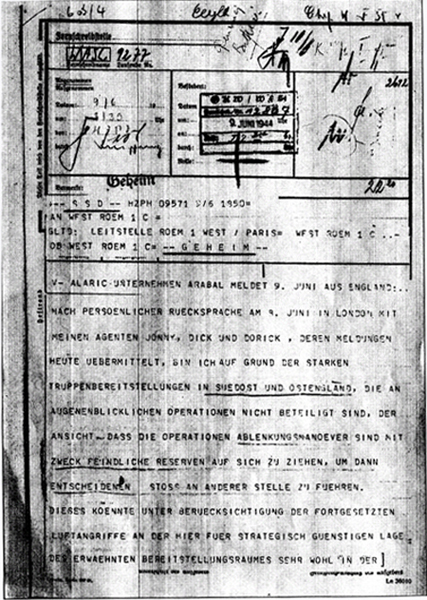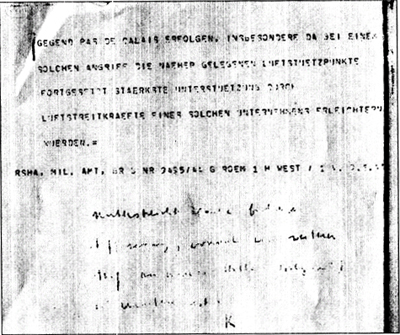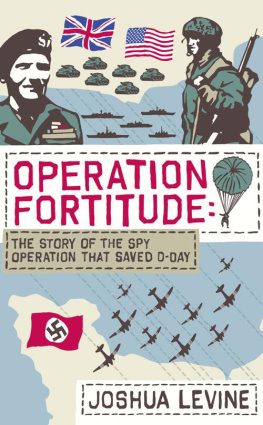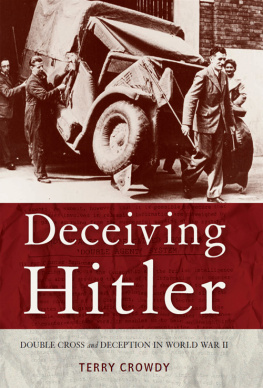First published in the United States in 2000 by
The Overlook Press, Peter Mayer Publishers, Inc.
Lewis Hollow Road
Woodstock, New York 12498
www.overlookpress.com
Copyright 2000 by St Ermins Press and Roger Hesketh
Introduction 1999 Westintel (Research) Ltd
First published in the U.K. by St Ermins Press/Little, Brown
All Rights Reserved. No part of this publication may be reproduced or transmitted in any form or by any means, electronic or mechanical, including photocopy, recording, or any information storage and retrieval system now known or to be invented without permission in writing from the publisher, except by a reviewer who wishes to quote brief passages in connection with a review written for inclusion in a magazine, newspaper, or broadcast.
ISBN 978-1-59020-948-6


by Nigel West
Strategic deception is now recognised as an essential component of any major military undertaking, and without exception the textbooks agree that the ingenious scheme, codenamed FORTITUDE, dreamed up to mislead the enemy over the long-expected invasion of Europe in 1944, was the most successful ever executed.
The challenge facing the Allies was their inability to conceal D-Days objectives. The Nazis anticipated an amphibious assault on the French coast, and the Wehrmachts military analysts saw the situation in much the same terms as their British and American counterparts, so the only issues to be resolved were limited to the exact timing and the precise location of the attack. The ultimate target was the capture of Berlin, which suggested the shortest route between Britain and the Continent, but on the way there were other considerations. The capture of a seaport intact was vital for the huge logistical support demanded by an army on the move, and it was presumed that exploiting the Channels narrowest point would allow maximum air cover over the combat zone and ensure that the troops arrived in the best condition, without enduring a long sea voyage. In addition, there was the political dimension introduced by the V-1 buzz bombs, which were scheduled to rain on London in June 1944, and thereby make the seizure of their launch sites an important priority.
On this logic the Pas de Calais seemed the obvious target area, a coastline boasting several useful ports, sufficiently close to Dover and Folkestone to guarantee almost immediate resupply of fuel, armour and ammunition, and continuous air support from the many RAF airfields in Kent. As for the timing, the weather and tides would be key factors, and there was little doubt about the imminent conflict.
From the German standpoint, the defence preparations had been made to allow Field Marshal Rommel considerable flexibility. The entire coast, from Holland to the Spanish frontier, had been fortified in depth and mobile armoured reserves had been located at strategic points to counter-attack while the invaders were at their most vulnerable, still fighting their way off the beaches. Although Allied air superiority restricted the opportunities for aerial reconnaissance, and improved signal security procedures prevented much information leaking over the airwaves, the High Command (OKW) did have what it perceived to be the great advantage of a sophisticated network of agents operated by the Abwehr which reported from numerous locations across England.
German confidence in its intelligence organisation was misplaced, for the spies that had been established in Britain had, without exception, fallen under the control of the Security Services, MI5. Every agent that had been infiltrated into the country had been picked up and, in the counter-intelligence argot, turned. In the example of GARBO, a colourful Catalan, he and his handler had embroidered his messages to include almost two dozen entirely notional sub-agents, all compiling detailed reports based on their purported observations, and drawing hefty expenses. To exploit this remarkable accomplishment, a highly secret deception unit had been created under the innocuous title of London Controlling Section, which acted as a clearing house to co-ordinate all Allied efforts to mislead the OKW about where, and when, the troops would storm what Hitler had termed Fortress Europe.
Led by Colonel John Bevan, LCS consisted of a small group of imaginative officers who masterminded a scheme of breathtaking audacity. SHAEF (Supreme Headquarters Allied Expeditionary Force) had long decided that, for such a hazardous assault to succeed, it would require whatever element of surprise could be extracted. Accordingly, SHAEF had opted to concentrate the landings in Normandy. In defiance of conventional military doctrine, the planners proposed to construct an entire harbour offshore, floating the concrete quays over from Devon, and lay an underwater fuel pipeline along the sea floor from the Isle of Wight. The planners calculated that whatever was lost by sacrificing air cover and the longer sea crossing would be outweighed by the advantage of landing unexpectedly in Normandy. As well as supervising and manipulating the whole of the enemys espionage system in Britain, LCS could count on two other clandestine assets. The first was access, through ULTRA, to German communications, which had enabled SHAEF to develop a comprehensive enemy order of battle and monitor its command structure. The second was a co-ordinated plan to use the local resistance groups to wreck the French landlines so as to increase the enemys reliance on wireless. Combined with the sabotage of selected bridges and railways, the purpose was to handicap the enemys ability to respond to the landings and ensure that the code-breakers at Bletchley Park anticipated the OKWs every decision.
It fell to LCS to make the project work, for if just one piece of the jigsaw failed to fit, the enemy might begin to suspect the deception and take the appropriate counter-measures. Tens of thousands of lives were in the balance, and a heavy responsibility fell on those devising FORTITUDE and on those charged with executing it. Once the overall strategy had been agreed, with the intention of reinforcing the German predisposition to expect a landing in the Pas de Calais, the various different components came into play. MI5 case officers handling a small group of trusted double agents were briefed, arrangements were made to generate false wireless traffic in East Anglia, and dummy landing craft and tanks were assembled in the Thames estuary to be photographed by enemy aircraft.
The quiet genius behind FORTITUDE was Roger Hesketh, a brilliantly intuitive, Eton-and Oxford-educated barrister, who, at the end of the war, prepared a classified account of the whole extraordinary story for very limited circulation within Whitehall. Naturally modest and reticent, Hesketh, later to be elected to Parliament in 1952 for his home town of Southport, retained several copies of the document, but never considered publishing it until 1973, when he was astonished to discover that the Daily Express journalist Sefton Delmer had been given access to it to write The Counterfeit Spy. While his account concentrated on the exploits of a double agent codenamed CATO, who was quite obviously GARBO, it obviously relied heavily on Heskeths Fortitude, with absolutely no acknowledgment. Outraged, Hesketh discovered that Delmer had been assisted by Colonel Noel Wild, one of his wartime subordinates, who had apparently also obtained a copy of Heskeths report. There was an exchange of fierce letters, and the result was a new edition of











